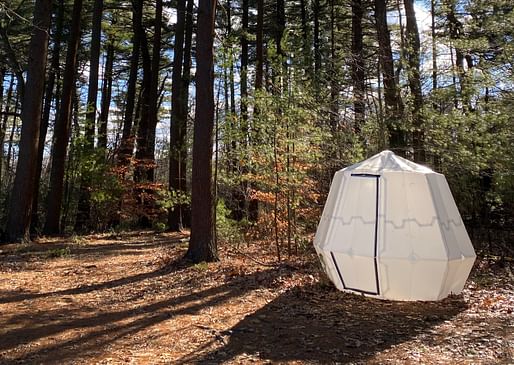

Researchers at the Harvard John A. Paulson School of Engineering and Applied Sciences (SEAS) have developed bistable inflatable structures inspired by origami, raising new possibilities for the future of emergency shelters, pop-up architecture, and even extra-terrestrial structures.
Many of today’s inflatable structures are monostable, meaning they require constant pressure to maintain an inflated state. A loss of pressure will return the structure to its original stable form – flat. The researchers at Harvard therefore asked “what if these structures had more than one stable state?” and set about developing a form that eould be just as stable inflated as it was flat on the ground.
The resulting design is inspired by origami and guided by geometry, developed through a library of triangular building blocks that can pop up, fold flat, or combine in different configurations to build closed, multistable shapes. “We are relying on the geometry of these building blocks, not the material characteristics, which means we can make these building blocks out of almost any material, including inexpensive recycled materials,” said Benjamin Gorissen, co-author of the paper recently published in Nature.
As a real-world test of their idea, the researchers designed and built an 8x4 foot inflatable shelter out of thick plastic sheets. They expect the shelter to be set up by one or two people, as opposed to the dozen or so needed to deploy today’s military field hospitals, for example.
The researchers see a variety of applications for their method in the built environment. As the building blocks of the origami structures can be mixed and matched to create a structure of any shape or size, researchers have already used the method to build an archway, an extendable boom, and a pagoda-style pavilion. “You can imagine these shelters being deployed as part of the emergency response in disaster zones,” said David Melancon, co-author of the paper. “They can be stacked flat on a truck and you only need one pressure source to inflate them. Once they are inflated, you can remove the pressure source and move onto the next tent.”
Applications of the building methods may even one day extend beyond Earth. “We’ve unlocked an unprecedented design space of large-scale inflatable structures that can fold flat and maintain their deployed shape without the risk of catastrophic rupture,” said Chuck Hoberman, the Pierce Anderson Lecturer in Design Engineering at the Graduate School of Design and co-author of the paper. “By using inflatable, reversible actuation to achieve hard-walled structural enclosures, we see important applications, not only here on Earth, but potentially as habitats for lunar or Mars exploration.”
5 Comments
I was fully prepared to hate the fuck out of this - see that soul crushing effort by VC tools - but this one makes sense, and the simplicity of setup, is going to be a tangible benefit under very extreme conditions, or circumstances.
Agreed on the eyeroll. But I gotta say I love "emergency architecture." I call dibs on that as my next firm name!
Glen Small and Ahde Lahti first year design studio, Cal Poly Pomona, 1971.
A year later some of these students and their instructors left CPP and started SCI-Arc.
That looks awesome!
Block this user
Are you sure you want to block this user and hide all related comments throughout the site?
Archinect
This is your first comment on Archinect. Your comment will be visible once approved.